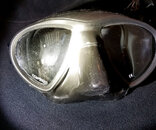Well, while you lot were boning up on sharks and boogers, I went diving yesterday.

To recap a previous post, I got a new Deep6 Gear mask a week or so ago. I ran it through the dishwasher (with some dirty dishes in there, too, using 1 pod of Cascade Platinum, normal wash, no heated dry). Then I let it soak for approximately 48 hours in lemon-scented household ammonia. I rinsed it well with water. That is the only treatment I gave it.
Yesterday, I squirted some diluted J&J Baby Shampoo in it, swished it around, maybe even rubbed it in there a bit with my finger (can't remember), then dumped it out and gave it one or two quick dunks in the lake, then put it on and went diving.
The water was 50-51F. I was in for 1 hour.
I never had a hint of fogging during the entire dive. Woo-F***KING-hooOOO!!!
Now, I have to put in my caveat. I have yet to find a mask that doesn't leak on me. That is why I currently have 10 or 15 masks. I keep buying new ones to try, hoping to find one that doesn't leak. Normally, because of leaking, I clear my mask numerous times during a dive. It seems like it is generally after clearing it a few times that I start getting fogging.
With the Deep6 mask yesterday, It also basically did not leak on me (another wooHOO!!). I think I cleared a tiny bit of water out of the bottom of the mask once or maybe twice during the whole dive. So, the mask performed awesomely, but I don't feel like I gave it a real torture test, either. And, it was only one dive.
I did a second dive, for 90 minutes. On that dive, I wore my Mako Minimus mask. The Mako has been the mask that leaks the least of all my masks. It also has been the most fog-prone. In its history, I have scrubbed it with Dawn detergent, I have burned it. I have scrubbed it with a Magic Eraser. And after reading the early parts of this thread, I ran it through the dishwasher. After the dishwasher, it has been the most fog-resistant it has ever been. But, I've still had dives where it leaked and I cleared it numerous times and eventually it started fogging.
I soaked the Mako in ammonia for 2 days also, last week.
Yesterday, I did it like the Deep6 mask. A squirt of diluted BS (LOL), a quick dunk or two in the lake, and then put it on and went diving. It really did not leak on me yesterday. And it was crystal clear for 45 or 50 minutes. At that point, it was still crystal clear, so I decided to really test it. I started exhaling completely out of my nose, instead of my mouth. I did that something like 3 or 4 full breaths, exhaled out of my nose.
After that, it did start fogging. It was not terrible, but it was quite noticeable. I came to the surface after 1 hour total, took it off, spit in it, rubbed that around, a couple of quick dunks, and back down for another 30 minutes. No real fogging on that last part.
So, I have an Atomic Subrame ARC in the ammonia bath right now. It will come out tonight (after ~48 hours). I ran the AA through the dishwasher, as well. I guess I'm going to find out how durable that ARC coating is.
When the Atomic comes out, per the request from
@lowviz, I will put the Deep6 mask back in for 5 more days. Maybe I'll go to the lake again next weekend and test the results of that...





